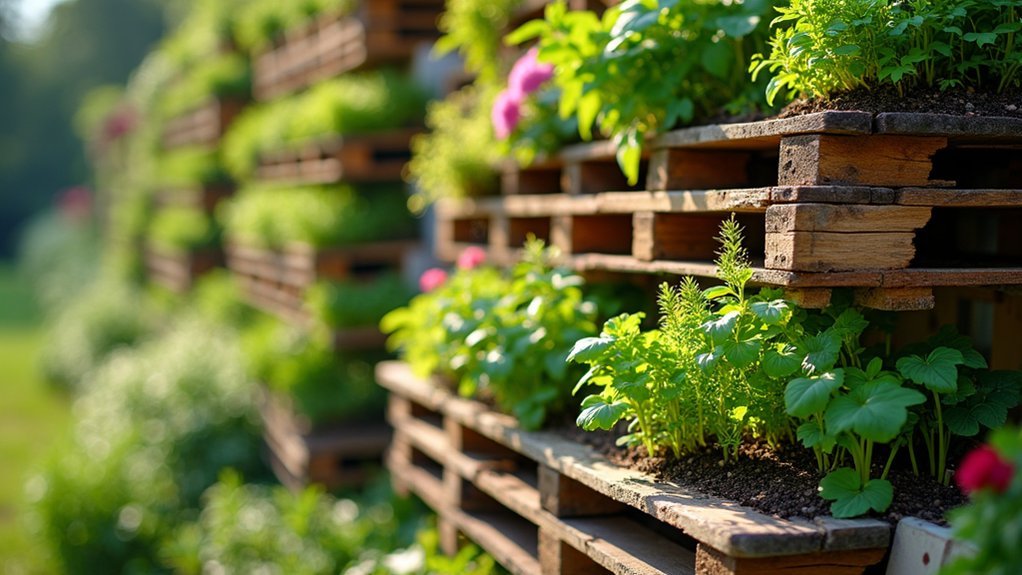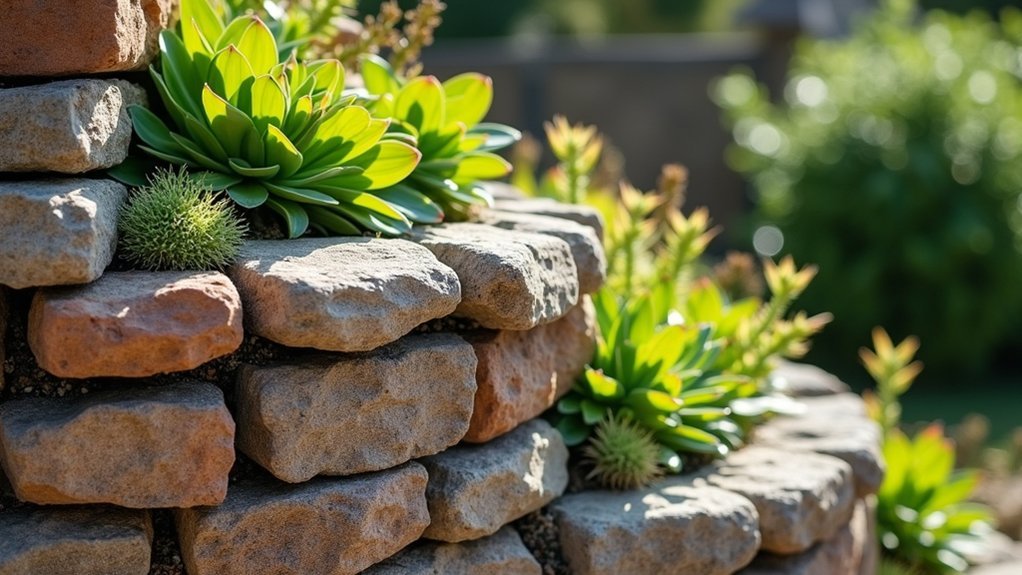You can build terraced plant fences using three simple methods: stacked wooden pallet tiers, multi-level raised bed fencing, or rock and brick terracing. Each approach creates organized growing zones while preventing soil erosion on slopes. Line your chosen structure with landscaping fabric, fill with quality soil, and select plants based on tier heights. Proper anchoring guarantees stability on uneven ground. These transformative solutions turn challenging slopes into productive, beautiful garden spaces.
Stacked Wooden Pallet Tiers: Creating Vertical Planting Zones

Three simple wooden pallets can transform your garden space into a multi-tiered growing paradise. When stacked and secured properly, these wooden pallets form effective terraced garden structures that maximize your limited space while preventing soil erosion on slopes.
Before filling your vertical garden, line each tier with landscaping fabric to retain soil while guaranteeing proper drainage.
Then, fill each level with quality soil mixed with compost to create an ideal growing environment. This nutrient-rich mixture will ensure your plants grow vigorously throughout the season.
For best results, anchor each tier firmly to prevent tipping, especially on uneven ground where they’ll function as natural retaining walls.
Plant herbs and compact vegetables across different levels to create a productive and visually appealing layout that makes the most of your vertical growing space.
Multi-Level Raised Bed Fencing for Sloped Gardens
While wooden pallets offer a quick terraced solution, more permanent multi-level raised bed fencing provides superior stability for challenging sloped gardens.
By creating flat planting areas at various heights, you’ll prevent soil erosion while maximizing usable space on your hillside property.
Transform slopes into productive spaces with multi-level planting areas that combat erosion and expand your gardening canvas.
Choose durable materials like wood or gabion walls to enhance both structural integrity and aesthetic appeal.
Plan each raised bed’s height (typically 1-3 feet) based on your intended plant types, ensuring proper root depth and easy maintenance access.
Don’t forget to incorporate a stairway or pathway between levels for convenient harvesting and garden care.
Adding protective fencing around your raised beds serves dual purposes: keeping unwanted animals away from your plants while maintaining an organized garden layout.
This thoughtful design transforms problematic slopes into productive, visually striking terraced landscapes.
Rock and Brick Terracing: Building Durable Plant Barriers

Creating robust terraced plant barriers with rock and brick offers unmatched durability against harsh weather conditions while effectively managing sloped terrain.
When constructing these terraced walls, begin by digging a foundation trench filled with gravel to guarantee proper drainage—critical for preventing erosion and water buildup.
Stack your durable materials to a maximum height of three feet, maintaining both functionality and visual appeal. You’ll find that incorporating drainage pipes or additional gravel layers between the rocks or bricks greatly extends the lifespan of your structure.
For enhanced soil stabilization, plant between the terraced wall sections. These plants’ root systems will further secure the soil while adding natural beauty to your hardscape.
The resulting terracing not only provides effective plant separation but also transforms challenging slopes into organized, usable garden spaces that will last for years.
Frequently Asked Questions
How to Create a Terraced Landscape?
You’ll need to assess your land’s slope, build retaining walls, create flat planting areas, add pathways between levels, select appropriate soil, and plan for regular maintenance to create a successful terraced landscape.
How to Build a Garden Fence to Keep Animals Out?
Install a 3-4 foot fence using welded wire or hardware cloth. Bury it 6-12 inches underground to stop burrowers. Add a tight-fitting gate for access, and regularly check for damage to maintain protection.
How to Terrace a Sloped Garden?
To terrace your sloped garden, clear vegetation first, then mark boundaries with string. Build retaining walls using timber or stone to create flat planting areas. Guarantee proper drainage and maintain regularly to prevent erosion.
How to Build a Terrace Garden?
Clear your area, then design two 8×20 foot sections separated by stairs. Mark boundaries with rebar and string, build raised beds with 4×4 lumber, secure with screws, fill with soil, and plant your seedlings.
In Summary
Terraced plant fences offer practical solutions for any garden challenge. Whether you’ve chosen wooden pallets for quick assembly, raised beds for sloping terrain, or rock and brick for lasting durability, you’ll enjoy both boundary definition and expanded growing space. Don’t hesitate to combine these methods to match your specific needs. With these techniques, you’ve transformed ordinary boundaries into productive, beautiful garden features that maximize your outdoor space.





Leave a Reply